With their glistening wings and mid-air gymnastics, dragonflies bring a sense of magic to any outdoor area. Even better, dragonflies act as natural pest controllers by eating mosquitoes and other unwanted insects. You can create an inviting habitat for dragonflies by growing plants that support their lifestyle. So let’s examine five amazing plants that attract dragonflies and help create a magical outdoor space with fewer pests.
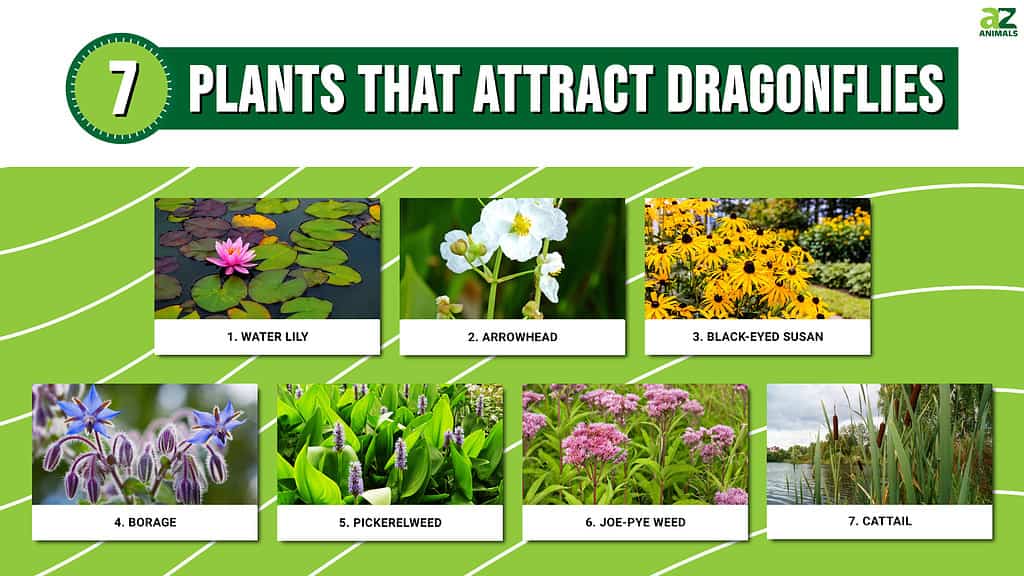
Attracting dragonflies with plants is also an approach to pest management called conservation biological control, or CBC. This is the practice of supporting specific parasitic and predatory insect populations to reduce the use of pesticides.
So, though you might want to attract dragonflies simply because you love them, you’ll also be doing the environment a favor by supporting their hunting success.
A Word of Warning About Dragonfly Appetites

Dragonflies are fierce hunters, always looking for more prey.
©Velela – Public Domain
Be aware that dragonflies are fierce predators with a huge appetite for more prey. And the animals they hunt include some creatures you might not want them to eat. For example, in addition to garden pests, dragonflies also eat butterflies.
Other animals that dragonflies (and their larvae) love to eat include bees and tadpoles. Large dragonflies might even eat a tiny fish or frog! So keep that in mind as you create a magical garden that also serves as a dragonfly hunting ground.
As a general rule, dragonflies don’t hunt anything bigger than their own bodies. But everything else in their path could be up for grabs.
What pest insects do dragonflies eat?
Dragonflies play a vital role in controlling the populations of various insect pests, making them highly beneficial to our ecosystems. Though they usually hunt flying insects, dragonflies also eat wingless insects like beetles.
Some of the insect pests that dragonflies commonly eat include:
In particular, mosquitoes are a favorite food source for dragonflies. So dragonflies can help reduce the health risks associated with mosquito populations.
Dragonflies also benefit farmers because they prey on agricultural pests such as aphids and leafhoppers, helping protect crops from invasive insects.
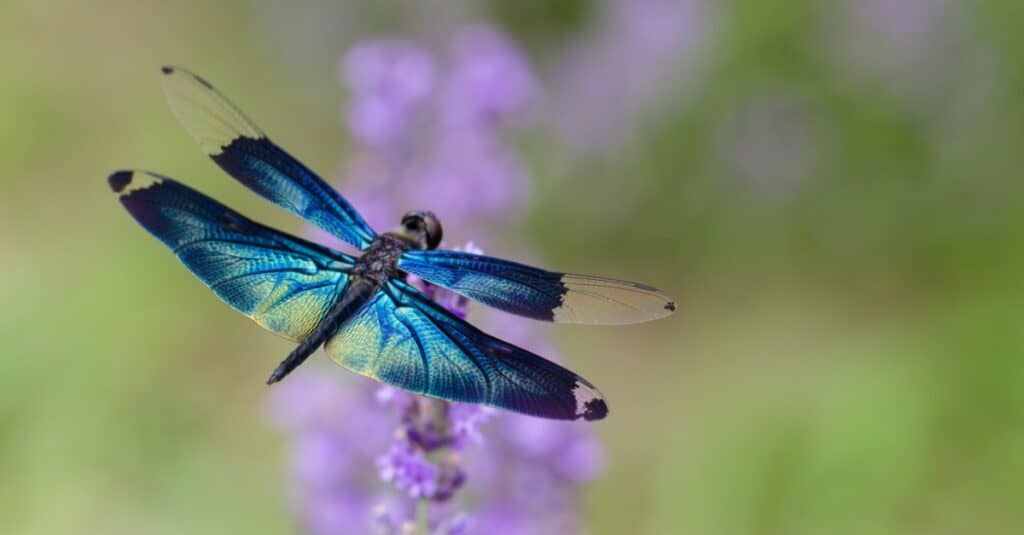
The best dragonfly habitats have pollinator-friendly plants.
©iStock.com/H_Yasui
Five Tips For Creating Dragonfly Habitats
Creating a dragonfly-friendly habitat involves more than just growing specific plants. There are other conditions, like water sources, to consider. So here are five tips for creating habitats that dragonflies won’t be able to resist.
- Grow various dragonfly-attracting plants from our list below to ensure they have a fertile hunting ground.
- Provide at least one water feature, such as a small pond, birdbath, or tub. This step is important because dragonflies lay their eggs in or next to the water. According to the Missouri Department of Conservation, many dragonfly nymphs (larvae) live and continue molting for up to 5 years in the water before ever taking flight. So water is essential for a dragonfly’s lifespan.
- Provide dragonfly larvae shelter and places to hide by growing aquatic plants in their water sources.
- Avoid using pesticides in or near their habitats, as the chemicals can kill the dragonflies and their prey.
- Add rocks or logs in both sunny and shaded areas of the habitat to provide resting spots for the dragonflies. These places to bask are essential near the water so that adult dragonflies can keep an eye on their larvae.

Water lilies are some of the best plants that attract dragonflies.
©Simon Groewe/Shutterstock.com
The Best Types of Plants That Attract Dragonflies
There are two main types of plants that will always attract dragonflies: plants that grow in the water (aquatic) and plants that attract pollinators.
- Aquatic plants: Dragonflies spend a lot of time near water, so aquatic plants like water lilies are an important part of their ideal habitat. These plants provide dragonflies with shade, resting areas, and hunting grounds.
- Plants that attract pollinators: Dragonflies hunt pollinator insects like bees, flies, and beetles. So growing plants (like borage) that attract pollinators will also attract dragonflies. Plants that attract pollinators produce high amounts of nectar and pollen.
Some of the best types of plants that attract dragonflies are listed below. Keep reading to learn about these amazing plants and how to create an ideal dragonfly habitat.

Water lilies provide shade and protection for dragonfly larvae.
©iStock.com/Harry Adam
1. Water Lily (Nymphaea)
Water lilies are aquatic plants with floating leaves and vibrant flowers. They provide shade and shelter for dragonfly larvae while creating a resting spot for adult dragonflies.
Water lilies also attract aphids, which dragonflies love to eat. This fact makes the water lily and the dragonfly even more simpatico.
Many different water lily cultivars are available in various colors, like pink, peach, lavender, orange, and bronze. However, hardy water lilies bloom only during daylight hours. The flowers close by evening and then open again at sunrise. The tropical water lily is available in varieties that bloom during the day or night.
Growing Water Lilies
Sunlight Needs: Full sun to partial shade
USDA Zones: 3-10 for hardy water lilies, 9-11 for tropical water lilies
Ideal Water Temperature: 70-75 degrees Fahrenheit on average, but can vary slightly depending on the type of water lily (hardy vs. tropical)
Blooming Seasons: Early Summer to Fall
There are two types of water lilies:
- Hardy (Zones 3–10): Can survive cooler water temperatures and winter dormancy.
- Tropical (Zones 9–11): Needs warmer water and needs to be stored over the winter to survive.
Choose the best type of water lily for your local climate.
The best way to grow a water lily plant is by placing its rhizome in a pot with soil and good drainage. The tip of the rhizome should be above the surface of the soil. Cover drainage holes with mesh to keep the soil from spilling out. Once potted, lower the water lily plant into a water feature, like a small pond or tub of water. Slide the pot into the water at a 45-degree angle to let the air inside release as it submerges. Ideally, the bottom of the pot should rest 12–16 inches deep. At that level, the plant’s new leaves should grow to float on the water’s surface.
Keep the water temperature between 70-75 degrees Fahrenheit for healthy water lily plants. Tropical water lilies should be stored over the winter to keep them alive.
The City Floral Garden Center of Denver recommends greenhouse storage for tropical water lilies. This practice includes keeping the plant in a tank or tub over the winter. However, when a greenhouse isn’t available, properly prepared tubers can be stored in a jar or bag of water in a cool, dark place until spring.

Also called duck potato, the arrowhead plant attracts pollinators that dragonflies love to eat.
©passion4nature/Shutterstock.com
2. Arrowhead (Saggitaria latifolia)
The arrowhead plant is an emergent aquatic perennial that grows in water but also rises up to 3 feet above the water’s surface. It produces showy white flowers, and most cultivars also grow arrowhead-shaped leaves. Arrowhead’s natural habits include stream margins, marshes, and swamps.
Dragonflies love arrowhead plants because they attract pollinators, provide shelter, and provide a place to rest above the water. These plants also offer a great vantage point for dragonflies hunting insects.
The arrowhead plant produces seeds and tubers that other animals, like birds and ducks, love to eat. Because of its edible tubers, this plant has the common names duck potato and swamp potato.
Growing Arrowhead Plants
Sunlight Needs: Full Sun
USDA Zones: 5-11, but some cultivars are not hardy below Zone 8
Ideal Water Temperature: 65-80 degrees Fahrenheit
Blooming Seasons: Mid to Late Summer
Broadleaf or common arrowhead has a strong and quickly-growing root system. This trait makes the common arrowhead an easy plant to establish in garden ponds, but it could eventually become invasive.
Common arrowhead seeds can take up to two years to fully germinate, so consider planting tubers instead. You can grow arrowhead tubers in a few inches of potted soil with the pointed ends facing up. Once the tubers root and produce small leaves, transplant them inside their pots to your garden pond. Keep plants close to the pond edge until they grow taller and can be moved to deeper water.
3. Black-Eyed Susan (Rudbeckia fulgida)
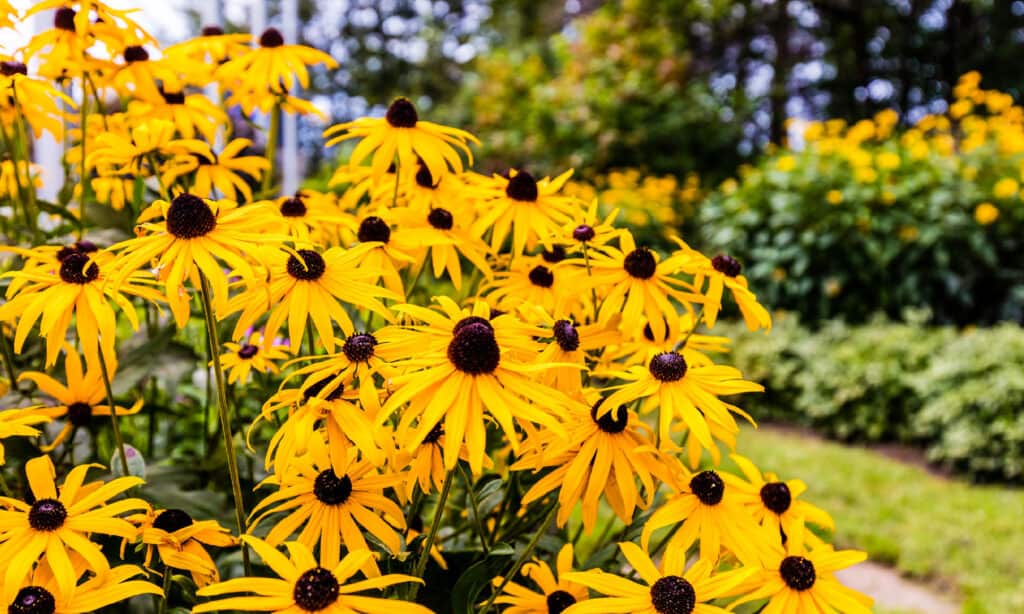
Dragonflies love black-eyed Susan plants for the bees and butterflies they attract.
©iStock.com/Dopeyden
The black-eyed Susan is an herbaceous perennial plant that produces yellow and orange flowers from late spring to early fall. This cheerful prairie flower attracts many pollinators and, therefore, also attracts hungry dragonflies. Black-eyed Susan flat flowerheads provide a comfortable landing pad for dragonflies on the hunt.
Black-eyed Susan is one of the easiest-to-grow plants that attract dragonflies because it is drought-tolerant and requires little maintenance. And it blooms for a long time between early summer and fall.
If you want to grow an annual version of the black-eyed Susan plant, choose a Rudbeckia hirta cultivar instead of Rudbeckia fulgida. However, Rudbeckia fulgida cultivars can be grown as annuals in tropical climates above USDA Zone 10.
Growing Black-Eyed Susan
Sunlight Needs: Full sun to partial shade
USDA Zones: 3–10
Blooming Seasons: Early Summer through Fall
You can easily grow black-eyed Susan plants in garden beds or containers. Provide your plants with moist, well-draining soil and full sun to partial shade. The plants mature to an average of 3 feet tall and can spread 2–3 feet wide. Remove the spent flowers to help black-eyed Susan plants produce more blooms.
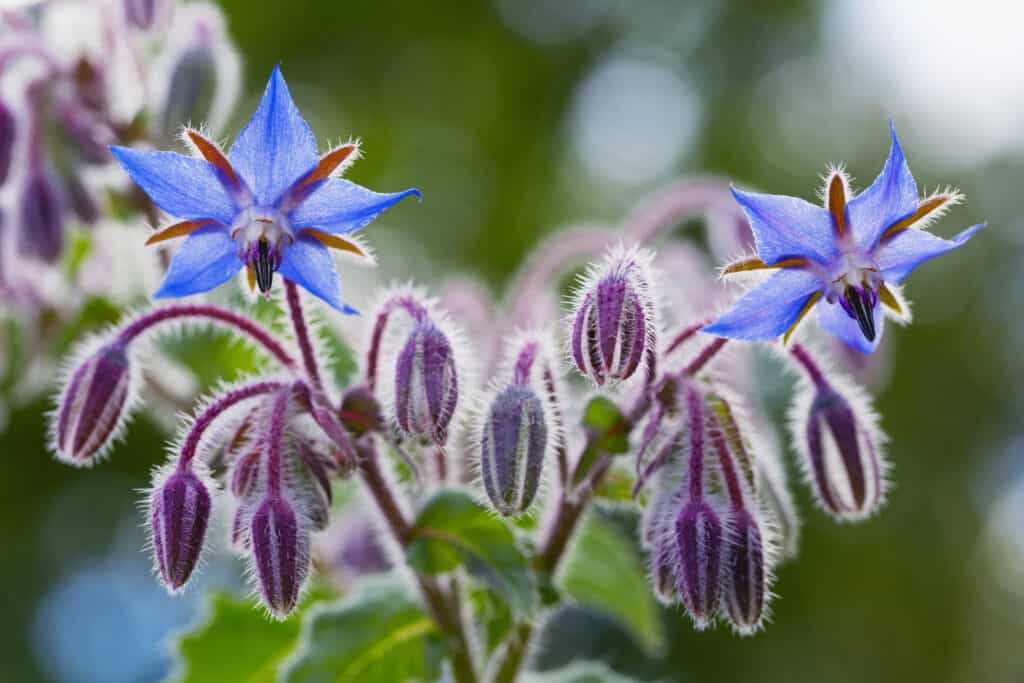
The borage plant attracts aphids and beetles, which are prey insects for dragonflies.
©matteo sani/Shutterstock.com
4. Borage (Borago officinalis)
The borage plant is a pretty addition to any garden with its star-shaped, baby blue flowers. And the local dragonflies will praise you for providing this bee and butterfly magnet! Plus, dragonflies can feast on plenty of aphids and beetles while helping prevent those pesky bugs from harming your borage plants.
Borage has downy grayish-green leaves and slightly nodding flowers that bloom in the summertime. In addition to attracting dragonflies, borage is also deer and rabbit-resistant. However, animals shy away from borage because it contains toxic compounds called pyrrolizidine alkaloids. According to the USDA, pyrrolizidine alkaloids are liver toxins for both humans and animals.
Growing Borage
Sunlight Needs: Full sun to partial shade
USDA Zones: 2-11
Blooming Seasons: Summer to Fall
Plant borage seedlings in a sunny garden spot when all danger of frost has passed. If you start them from seed indoors first, watch for the size of this plant’s taproot. Make sure to transplant the seedlings into garden pots and beds before their taproots get oversized. Thin out the borage plants when the seedlings are 2–3 inches tall. Borage should grow an average of 3 feet high. Remove the dead flowers throughout the growing season.

Pickerelweeds are aquatic plants that provide great hunting grounds for dragonflies.
©Gert-Jan van Vliet/Shutterstock.com
5. Pickerelweed (Pontederia cordata)
For dragonfly enthusiasts, pickerelweed is a must-have aquatic plant for ponds and other water features. Pickerelweed attracts some of the dragonfly’s favorite prey, like leaf beetles.
This emergent (rises above the water) perennial grows on the margins of shallow water and produces clusters of tiny violet-blue flowers on tall stalks. Pickerelweed also has large, glossy, lance-shaped leaves perfect as dragonfly landing pads. This aquatic plant that grows up to 3 feet tall provides shelter and shade for dragonfly larvae.
Growing Pickerelweed
Sunlight Needs: Full sun
USDA Zones: 3-10
Ideal Water Temperature: 65-80 degrees Fahrenheit
Blooming Seasons: Summer to Fall
Like other aquatic plants on this list, pickerelweed is easier to grow if you place the potted plant in your water feature. In addition, growing pickerelweed in pots under the water’s surface prevents root overgrowth throughout your garden pond or tub. You can also plant pickerelweed from seed along the banks and margins of water features too.
Place potted pickerelweed plants about 5 inches deep in the water. Keep them submerged and in sunny areas. Dig up and divide their rhizomes to repot every few growing seasons.
Your pickerelweed plants should survive the winter in Zones 3–10 if pruned properly before the first frost. For overwintering, cut the plant back to its crown (the spot where the roots meet the stem) and submerge it in at least 4 inches of water.
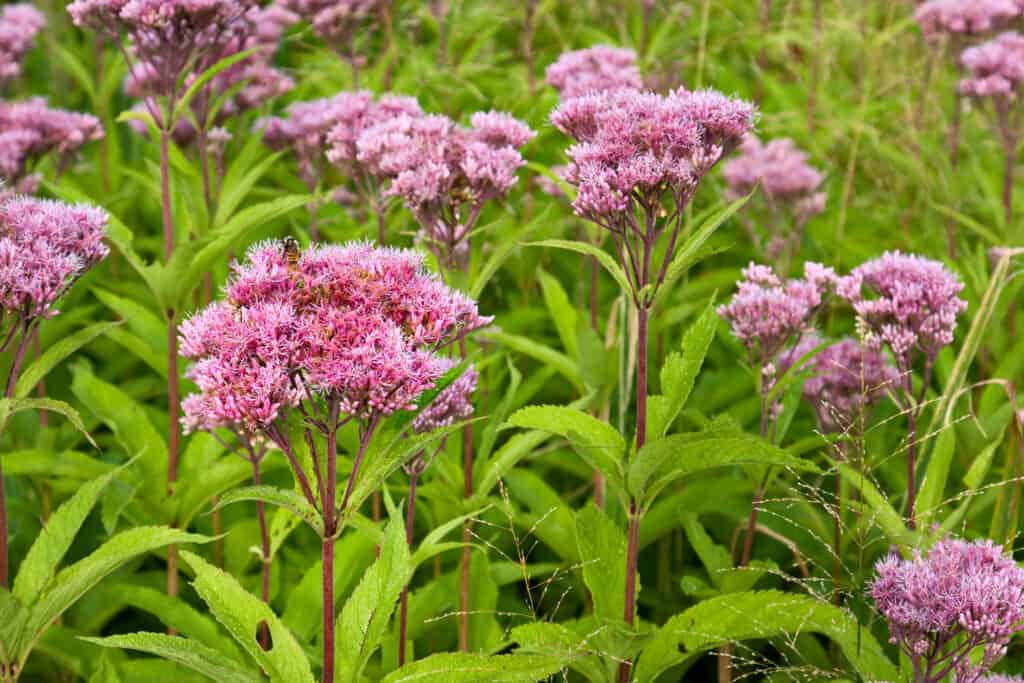
The Joe-Pye weed is a perennial plant that smells like vanilla and attracts dragonflies to the garden.
©Stephen Bonk/Shutterstock.com
6. Joe-Pye Weed (Eutrochium purpureum)
Sweet-scented Joe-Pye weed is a showy ornamental plant with massive clusters of tiny mauve flowers. Dragonflies love this plant because it attracts the pollinators they love to eat, while the pollinators love Joe-Pye weed’s sweet vanilla scent.
Additionally, Joe-Pye weed attracts birds for the abundant seed pods this perennial produces. The birds you might attract to your garden include the American goldfinch, dark-eyed junco, and Carolina wren.
Note that though Joe-Pye weed isn’t invasive (it is native to North America), it’s a robust self-seeding plant. So don’t be surprised if you end up with unintended additional plants that pop up during future growing seasons.
Growing Joe-Pye Weed
Sunlight Needs: Full sun to partial shade
USDA Zones: 3-9
Blooming Seasons: Summer to Fall
Make lots of room in the garden for your showy Joe-Pye weed plants because they can reach 5-7 feet tall and spread 2-4 feet wide! But that means there’s all the more room for dragonflies to rest and find their next meal.
Also called marsh milkweed, Joe-Pye weed thrives in full to partial sun and moist, well-draining soil. It’s easy to grow, but this plant doesn’t do well in drought conditions. So you’ll want to water Joe-Pye weed plants consistently.
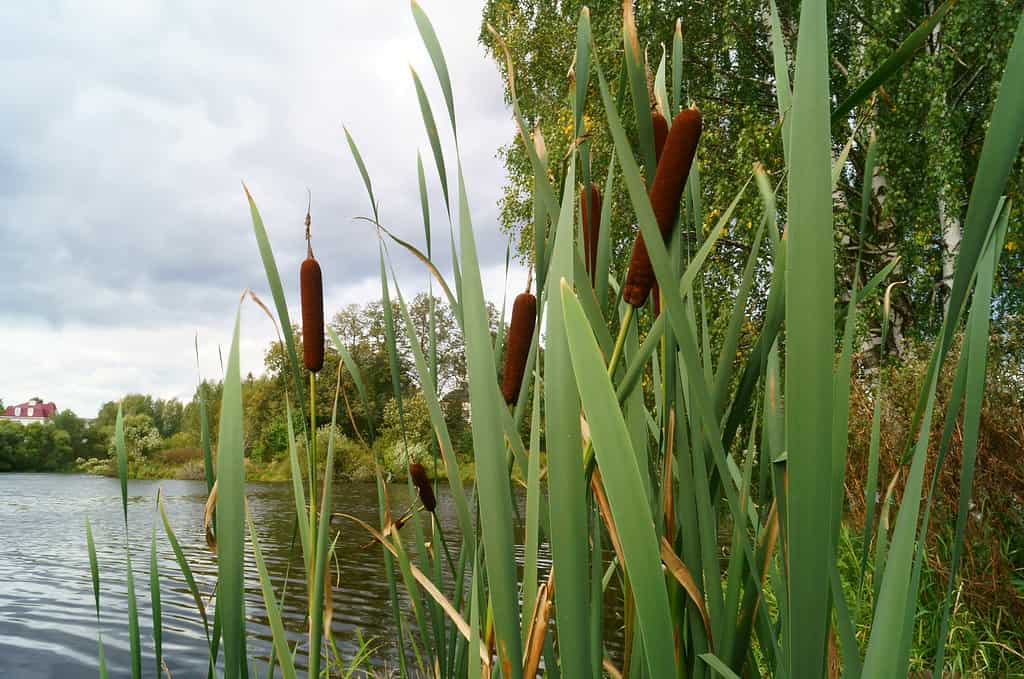
Tall cattail plants attract dragonfly prey like bees, moths, and beetles.
©Panchuali/Shutterstock.com
7. Cattail (Typha latifolia)
The cattail is one of the most recognizable emergent aquatic plants, and it’s another amazing plant that attracts dragonflies. These tall plants are perfect for dragonfly perching. Their long, thin leaves provide shelter and shade for adult dragonflies and larvae alike.
These iconic plants also attract pollinators like bees, butterflies, moths, and beetles. So you can expect to see dragonflies searching through the cattails for their next snack.
Did you know that the brown, cigar-looking shapes on cattail plants are actually their flowers? The brown portion of the cattail flower is female, and the spike growing out the top is the male part of the flower.
Growing Cattail Plants
Sunlight Needs: Full sun
USDA Zones: 3-10
Ideal Water Temperature: 60-75 degrees Fahrenheit
Blooming Seasons: Spring through Fall
Before you plant cattails in your garden water features, know they grow and expand rapidly. These plants reproduce so quickly that they’re like the fertile bunnies of the aquatic plant world. In fact, each cattail flower can produce up to 300,000 seeds!
So be ready to control your cattails with whatever methods work best for you. For example, Cornell Cooperative Extension suggests controlling cattails by hand-pulling, dredging the pond, or lowering the water level in the fall to the point where the roots will freeze over the winter.
Plant cattail seeds in small pots with wet soil after soaking the seeds for 3–4 hours first. Let them germinate for two weeks or up to two months. Transplant the seedlings around the banks of ponds with shallow water where the plants can get at least 8 hours of full sun daily.
Plants that attract dragonflies are ones that pollinators adore.
Where there are pollinators, there will also be dragonflies. And if you grow pollinator-friendly plants in or near water, you’ll create a magical dragonfly oasis! Plus, all of your garden plants will benefit from dragonfly-style pest control.
Remember to provide supportive dragonfly habitats by setting up at least one water feature with aquatic plants where dragonflies can lay their eggs. Tiny dragonfly larvae will appreciate the plants overhead that provide shade and protect them as they mature.
Summary of 7 Amazing Plants That Attract Dragonflies
| Rank | Plant |
|---|---|
| 1 | Water Lily |
| 2 | Arrowhead |
| 3 | Black-Eyed Susan |
| 4 | Borage |
| 5 | Pickerelweed |
| 6 | Joe-Pye Weed |
| 7 | Cattail |
The photo featured at the top of this post is © Costea Andrea M/Shutterstock.com
Thank you for reading! Have some feedback for us? Contact the AZ Animals editorial team.






